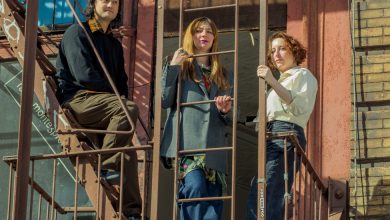A Classic Parisian Apartment Filled With Modern Design

IN THE FALL of 2019, the architect and designer Sophie Dries, 35, and her partner, the sculptor Marc Leschelier, 37, moved into a two-bedroom Haussmannian apartment in Paris’s 11th Arrondissement, not far from the city’s historic Place des Vosges. For several months, they lived almost entirely without furniture or household comforts, save for a mattress on the bedroom floor — which doubled as a hangout area and home office — and two dinner plates. They had no interest in buying stopgap items and wanted to take time to acquaint themselves with the space before making it their own. “We would completely avoid the living room, though,” Dries says. “It was so empty, it had an echo.”
But the couple weren’t exactly starting with a blank slate. The 1,450-square-foot second-floor apartment is an archetypal 19th-century Parisian home, complete with all the trappings of the era’s refined, decorative architecture. The 10-foot-high ceilings have ornate, botanically themed moldings; the walls are wainscoted; and the floors retain their original geometric two-tone marquetry. At the western end of the 376-square-foot living room, there is an elaborately sculpted marble fireplace inscribed with the year of its creation, 1853, and on the adjacent wall a row of floor-to-ceiling French windows open onto a balcony overlooking the wide, tree-lined boulevard below. The home, in other words, was designed to be a sumptuous backdrop for the gilded commodes and carved-leg bergères of its time. But Dries and Leschelier — who met not long after they both graduated from the architecture program at Paris’s École des Beaux-Arts — had an entirely different vision for it. “We wanted to create a clash between this bourgeois typical Haussmannian home and contemporary furniture and ideas,” says Dries. “We live on the old continent, and we love its sense of history, but we’re young — it’s important to have that paradox.”
SINCE FOUNDING HER namesake architecture and design studio in 2014, Dries has built a portfolio of residential projects in Paris — including a minimalist penthouse on the Rue Saint-Honoré for a pair of art collectors and an elegantly stripped-back two-bedroom near the Canal Saint-Martin for a young couple who work in fashion and tech — that each serve as a deft portrait of their residents while reflecting Dries’s own interests in combining pure lines with rich textures and unusual materials. With his raw large-scale sculptures — often pavilion-esque concrete forms — Leschelier similarly seeks to introduce a sense of spontaneity and experimentation into the architectural process. This shared sensibility, which rejects hierarchies of old and new, form and function, is evident throughout the pair’s home. Beginning in December 2019, they slowly furnished the apartment, which has a traditional circular layout — a living room and a dining room lead off an entryway, and the more private rooms, including the bedroom and a nursery for the couple’s 3-month-old daughter, Daria, flow into one another from there — over a two-year period, mixing pieces by designers such as Philippe Starck and Ettore Sottsass (acquired mostly through Paris-based gallerists, including Paul Bourdet and Yves and Victor Gastou) with Dries’s own handcrafted creations.

In the living room, a Rick Owens chair, a Max Lamb coffee table and a sofa by Dries. The floor lamp is by Déborah Bowman.Credit…Matthew Avignone
Arrangements were often informed by affinities that Dries or Leschelier noticed between seemingly unrelated items. In the living room, for example, the couple paired a dining table with a wavy-edged oval oak top, and tubular rusted steel legs by Dries with a set of Starck’s ’80s-era steel Von Vogelsang chairs for Driade. A 10-by-6 1/2-foot framed print by Ryan McGinley depicting three nude figures sprawled across a sand dune covers almost the entire south wall. Dries shared images of the room with the British designer Max Lamb, who then created a slablike rubber coffee table for the space in a complementary shade of peanut butter brown. The piece now sits beside a crescent-moon-shaped modular sofa, designed by Dries and upholstered in deep aubergine velvet, that like the floor is made from oak but in a more contemporary burled veneer.
Leschelier also contributed custom works to the living room: two console tables composed of steel-topped stacked cinder blocks sealed with overflowing mortar that sit on either side of one of the French windows. Dries, too, often elevates raw, humble elements in her practice and counts the postwar Italian Arte Povera movement, which championed everyday materials, and the minimalism of the French Modernist interior designer Jean-Michel Frank among her references. “Frank was a punk of his time, and I often wonder what he’d do today,” she says. For the couple’s bedroom, a warm but restrained refuge defined by earth tones and natural textures, she used a slap brush to apply an organic, craggy white plaster finish to the tall built-in closets, and she had curtains made from roughly woven hessian, a fabric typically used in upholstery. The sun-flooded dining room, adjacent to the living room, features one of her brass Glow chandeliers, designed for the lighting company Kaia, whose egg-shaped glass globes are topped with molded papier-mâché cases. And for the small galley kitchen at the far end of the apartment, she chose a blue-gray polished concrete to cover the countertops and floor, a refreshing departure from the beige and white palette her clients so often request.
Dries and Leschelier share an appreciation for works with a sense of humor. They are fans, for example, of the expressive approach of the Italian designer Gaetano Pesce, and one of his anthropomorphic, brightly colored hand-poured resin Nobody’s Perfect chairs sits — near a plush purple and green tufted wool rug by Dries for Nilufar Gallery that evokes an otherworldly animal pelt — in the corner of the apartment’s vestibule, a hushed, jewel-box-like space where the couple’s eclectic tastes are most fully on display. To amplify the room’s intimate, denlike feel, Dries upholstered the walls in jade green Japanese straw. Then, taking inspiration from the Barnes Foundation in Philadelphia — in which old masters and personal curiosities amassed over decades by the early 20th-century collector Albert C. Barnes are displayed side by side — she hung some of the couple’s smaller-scale artworks salon-style across them. A religious engraving by the German Renaissance master Albrecht Dürer, inherited from Leschelier’s maternal grandmother, appears not far from a photograph of an English breakfast by the British photographer Martin Parr; an engraved landscape by Dries and Leschelier’s close friend the French conceptual artist Laurent Grasso offsets a floral still life by the young Azerbaijani painter Niyaz Najafov. “The room has no function, but it’s our favorite,” Dries says. “We wanted to find an absurd way of putting things together without any thought of value.”
Now that the living room no longer has an echo, the couple make full use of it by hosting friends for aperitifs. While neither claims to be a great cook, they both delight in sharing a bottle of Chablis — or, when the occasion calls for it, a gin and tonic or two — with their loved ones, and it is in this room, too, that they spend the most time with their daughter. But for Dries, the family’s home is also a professional manifesto of sorts, a way to illustrate that a more idiosyncratic living space can hold great allure. “My clients might be too afraid to do most of the things here,” she says. “But if they see them in the context of a traditional apartment, they might change their minds.”
Photo assistant: Lilly Merck





